Knowledge Management Report: BISY3005 for Wesfarmers Analysis
VerifiedAdded on 2023/01/20
|13
|3389
|78
Report
AI Summary
This report offers a comprehensive analysis of knowledge management within Wesfarmers, examining its core concepts, principles, and practical applications. The report explores how knowledge management contributes to organizational effectiveness by facilitating information sharing, problem-solving, and strategic planning. It also critically assesses the negative impacts of ineffective knowledge management, such as reduced efficiency and innovation. Furthermore, the report delves into common approaches to knowledge management, including knowledge capture, conversion, and storage, alongside a discussion of knowledge and information policies. The analysis covers the development and use of these policies within organizations, highlighting their role in fostering competitiveness and achieving business objectives. The report provides insights into how Wesfarmers can leverage knowledge management to improve its operations and achieve its strategic goals.
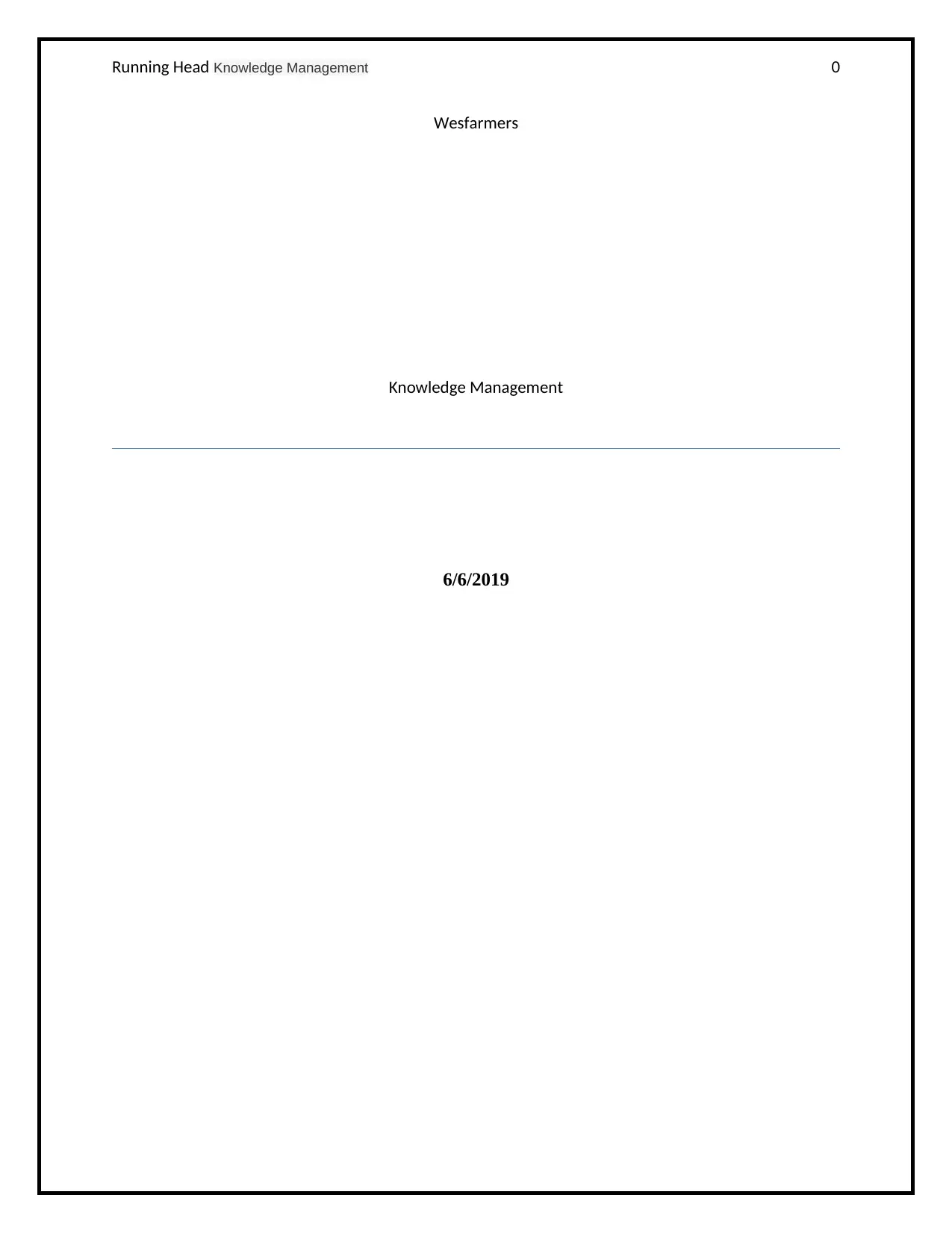
Running Head Knowledge Management 0
Wesfarmers
Knowledge Management
6/6/2019
Wesfarmers
Knowledge Management
6/6/2019
Paraphrase This Document
Need a fresh take? Get an instant paraphrase of this document with our AI Paraphraser
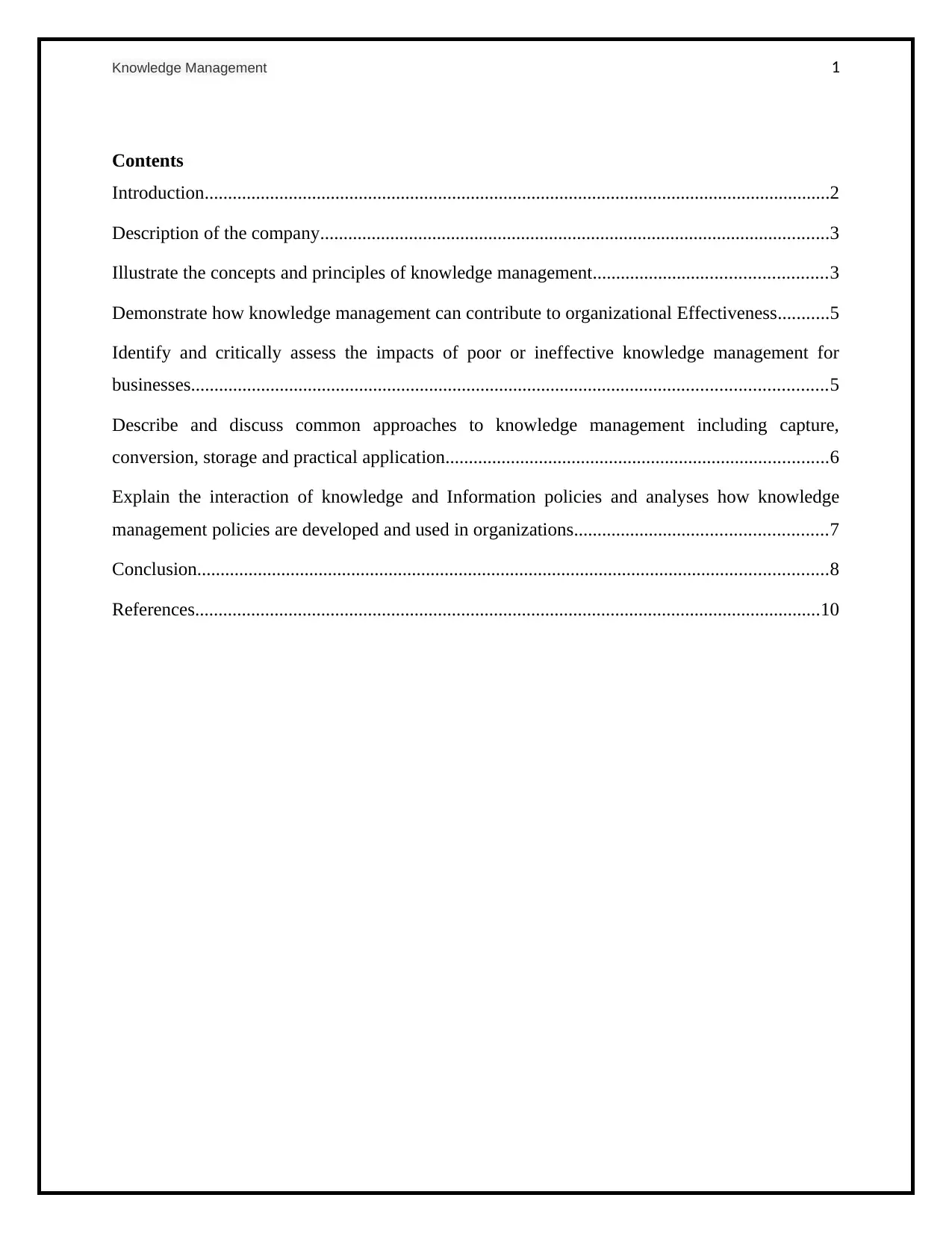
Knowledge Management 1
Contents
Introduction......................................................................................................................................2
Description of the company.............................................................................................................3
Illustrate the concepts and principles of knowledge management..................................................3
Demonstrate how knowledge management can contribute to organizational Effectiveness...........5
Identify and critically assess the impacts of poor or ineffective knowledge management for
businesses........................................................................................................................................5
Describe and discuss common approaches to knowledge management including capture,
conversion, storage and practical application..................................................................................6
Explain the interaction of knowledge and Information policies and analyses how knowledge
management policies are developed and used in organizations......................................................7
Conclusion.......................................................................................................................................8
References......................................................................................................................................10
Contents
Introduction......................................................................................................................................2
Description of the company.............................................................................................................3
Illustrate the concepts and principles of knowledge management..................................................3
Demonstrate how knowledge management can contribute to organizational Effectiveness...........5
Identify and critically assess the impacts of poor or ineffective knowledge management for
businesses........................................................................................................................................5
Describe and discuss common approaches to knowledge management including capture,
conversion, storage and practical application..................................................................................6
Explain the interaction of knowledge and Information policies and analyses how knowledge
management policies are developed and used in organizations......................................................7
Conclusion.......................................................................................................................................8
References......................................................................................................................................10
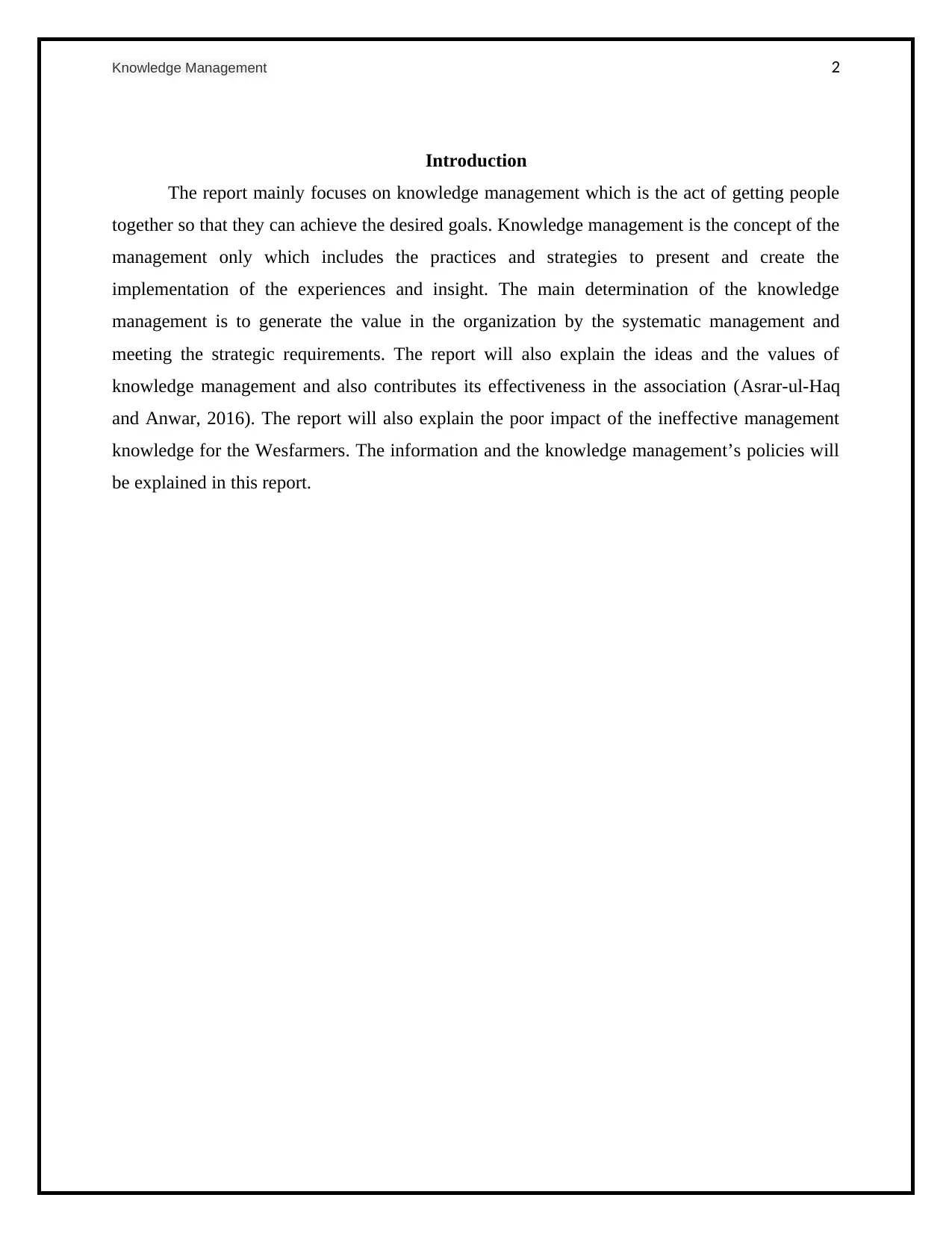
Knowledge Management 2
Introduction
The report mainly focuses on knowledge management which is the act of getting people
together so that they can achieve the desired goals. Knowledge management is the concept of the
management only which includes the practices and strategies to present and create the
implementation of the experiences and insight. The main determination of the knowledge
management is to generate the value in the organization by the systematic management and
meeting the strategic requirements. The report will also explain the ideas and the values of
knowledge management and also contributes its effectiveness in the association (Asrar-ul-Haq
and Anwar, 2016). The report will also explain the poor impact of the ineffective management
knowledge for the Wesfarmers. The information and the knowledge management’s policies will
be explained in this report.
Introduction
The report mainly focuses on knowledge management which is the act of getting people
together so that they can achieve the desired goals. Knowledge management is the concept of the
management only which includes the practices and strategies to present and create the
implementation of the experiences and insight. The main determination of the knowledge
management is to generate the value in the organization by the systematic management and
meeting the strategic requirements. The report will also explain the ideas and the values of
knowledge management and also contributes its effectiveness in the association (Asrar-ul-Haq
and Anwar, 2016). The report will also explain the poor impact of the ineffective management
knowledge for the Wesfarmers. The information and the knowledge management’s policies will
be explained in this report.
⊘ This is a preview!⊘
Do you want full access?
Subscribe today to unlock all pages.

Trusted by 1+ million students worldwide
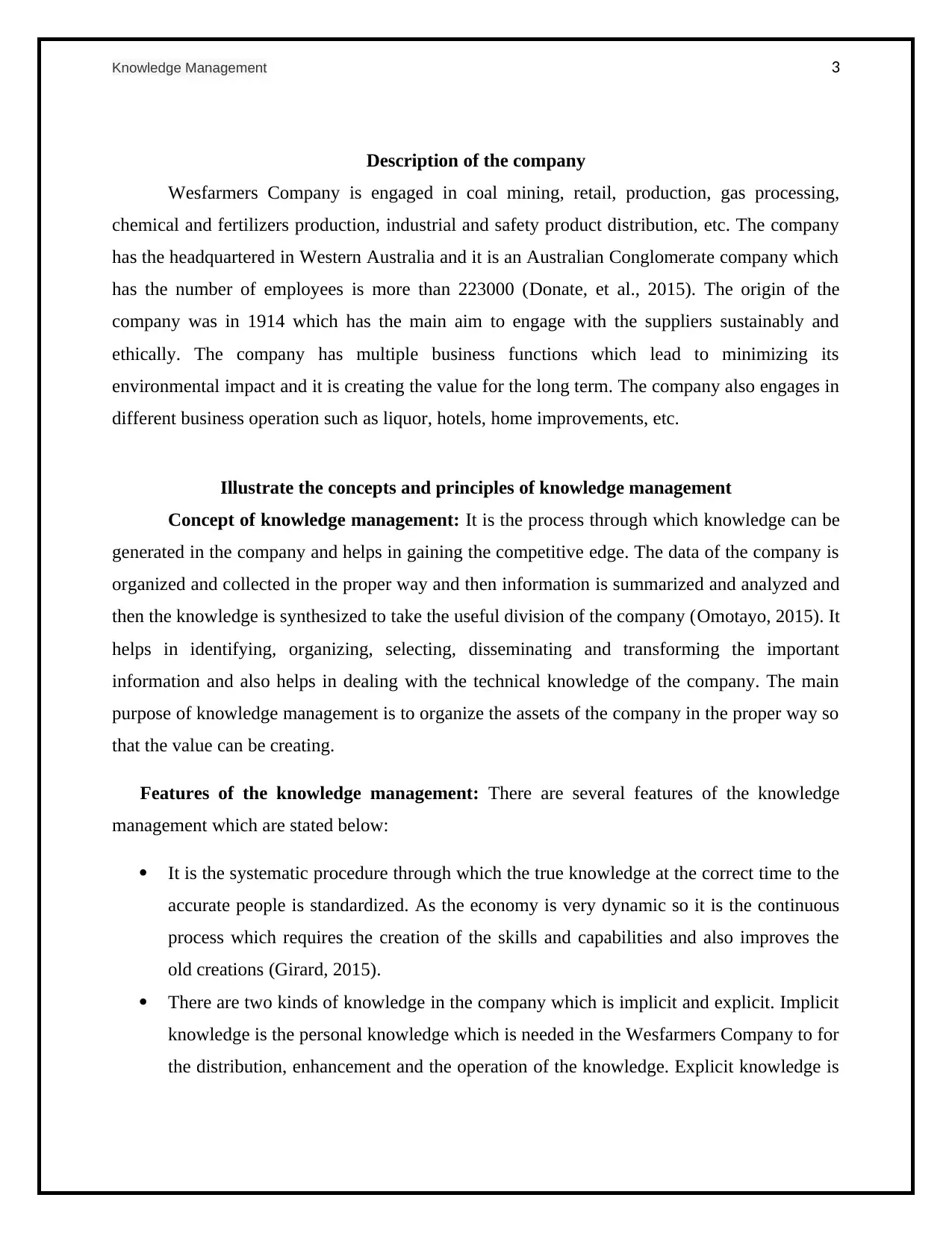
Knowledge Management 3
Description of the company
Wesfarmers Company is engaged in coal mining, retail, production, gas processing,
chemical and fertilizers production, industrial and safety product distribution, etc. The company
has the headquartered in Western Australia and it is an Australian Conglomerate company which
has the number of employees is more than 223000 (Donate, et al., 2015). The origin of the
company was in 1914 which has the main aim to engage with the suppliers sustainably and
ethically. The company has multiple business functions which lead to minimizing its
environmental impact and it is creating the value for the long term. The company also engages in
different business operation such as liquor, hotels, home improvements, etc.
Illustrate the concepts and principles of knowledge management
Concept of knowledge management: It is the process through which knowledge can be
generated in the company and helps in gaining the competitive edge. The data of the company is
organized and collected in the proper way and then information is summarized and analyzed and
then the knowledge is synthesized to take the useful division of the company (Omotayo, 2015). It
helps in identifying, organizing, selecting, disseminating and transforming the important
information and also helps in dealing with the technical knowledge of the company. The main
purpose of knowledge management is to organize the assets of the company in the proper way so
that the value can be creating.
Features of the knowledge management: There are several features of the knowledge
management which are stated below:
It is the systematic procedure through which the true knowledge at the correct time to the
accurate people is standardized. As the economy is very dynamic so it is the continuous
process which requires the creation of the skills and capabilities and also improves the
old creations (Girard, 2015).
There are two kinds of knowledge in the company which is implicit and explicit. Implicit
knowledge is the personal knowledge which is needed in the Wesfarmers Company to for
the distribution, enhancement and the operation of the knowledge. Explicit knowledge is
Description of the company
Wesfarmers Company is engaged in coal mining, retail, production, gas processing,
chemical and fertilizers production, industrial and safety product distribution, etc. The company
has the headquartered in Western Australia and it is an Australian Conglomerate company which
has the number of employees is more than 223000 (Donate, et al., 2015). The origin of the
company was in 1914 which has the main aim to engage with the suppliers sustainably and
ethically. The company has multiple business functions which lead to minimizing its
environmental impact and it is creating the value for the long term. The company also engages in
different business operation such as liquor, hotels, home improvements, etc.
Illustrate the concepts and principles of knowledge management
Concept of knowledge management: It is the process through which knowledge can be
generated in the company and helps in gaining the competitive edge. The data of the company is
organized and collected in the proper way and then information is summarized and analyzed and
then the knowledge is synthesized to take the useful division of the company (Omotayo, 2015). It
helps in identifying, organizing, selecting, disseminating and transforming the important
information and also helps in dealing with the technical knowledge of the company. The main
purpose of knowledge management is to organize the assets of the company in the proper way so
that the value can be creating.
Features of the knowledge management: There are several features of the knowledge
management which are stated below:
It is the systematic procedure through which the true knowledge at the correct time to the
accurate people is standardized. As the economy is very dynamic so it is the continuous
process which requires the creation of the skills and capabilities and also improves the
old creations (Girard, 2015).
There are two kinds of knowledge in the company which is implicit and explicit. Implicit
knowledge is the personal knowledge which is needed in the Wesfarmers Company to for
the distribution, enhancement and the operation of the knowledge. Explicit knowledge is
Paraphrase This Document
Need a fresh take? Get an instant paraphrase of this document with our AI Paraphraser
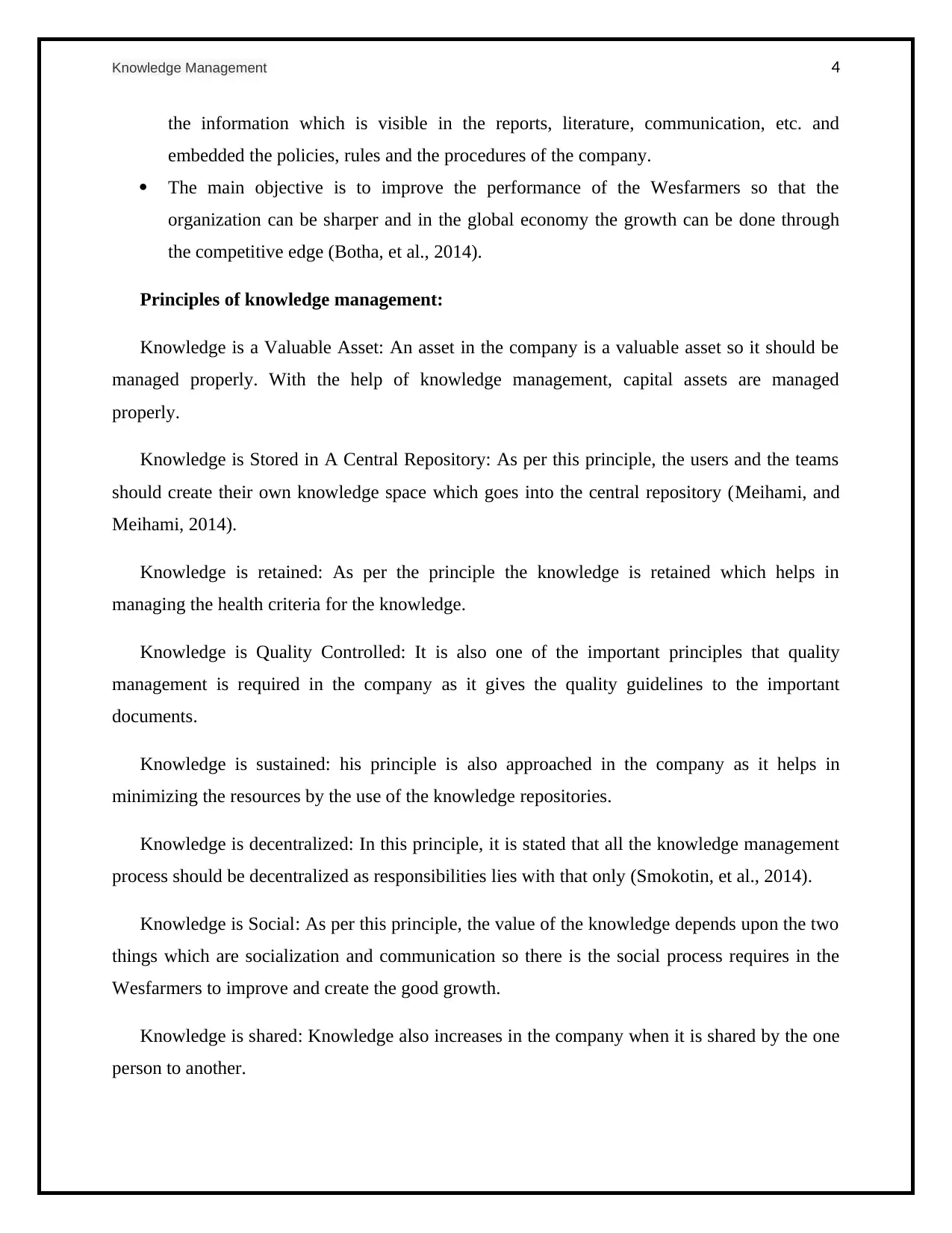
Knowledge Management 4
the information which is visible in the reports, literature, communication, etc. and
embedded the policies, rules and the procedures of the company.
The main objective is to improve the performance of the Wesfarmers so that the
organization can be sharper and in the global economy the growth can be done through
the competitive edge (Botha, et al., 2014).
Principles of knowledge management:
Knowledge is a Valuable Asset: An asset in the company is a valuable asset so it should be
managed properly. With the help of knowledge management, capital assets are managed
properly.
Knowledge is Stored in A Central Repository: As per this principle, the users and the teams
should create their own knowledge space which goes into the central repository (Meihami, and
Meihami, 2014).
Knowledge is retained: As per the principle the knowledge is retained which helps in
managing the health criteria for the knowledge.
Knowledge is Quality Controlled: It is also one of the important principles that quality
management is required in the company as it gives the quality guidelines to the important
documents.
Knowledge is sustained: his principle is also approached in the company as it helps in
minimizing the resources by the use of the knowledge repositories.
Knowledge is decentralized: In this principle, it is stated that all the knowledge management
process should be decentralized as responsibilities lies with that only (Smokotin, et al., 2014).
Knowledge is Social: As per this principle, the value of the knowledge depends upon the two
things which are socialization and communication so there is the social process requires in the
Wesfarmers to improve and create the good growth.
Knowledge is shared: Knowledge also increases in the company when it is shared by the one
person to another.
the information which is visible in the reports, literature, communication, etc. and
embedded the policies, rules and the procedures of the company.
The main objective is to improve the performance of the Wesfarmers so that the
organization can be sharper and in the global economy the growth can be done through
the competitive edge (Botha, et al., 2014).
Principles of knowledge management:
Knowledge is a Valuable Asset: An asset in the company is a valuable asset so it should be
managed properly. With the help of knowledge management, capital assets are managed
properly.
Knowledge is Stored in A Central Repository: As per this principle, the users and the teams
should create their own knowledge space which goes into the central repository (Meihami, and
Meihami, 2014).
Knowledge is retained: As per the principle the knowledge is retained which helps in
managing the health criteria for the knowledge.
Knowledge is Quality Controlled: It is also one of the important principles that quality
management is required in the company as it gives the quality guidelines to the important
documents.
Knowledge is sustained: his principle is also approached in the company as it helps in
minimizing the resources by the use of the knowledge repositories.
Knowledge is decentralized: In this principle, it is stated that all the knowledge management
process should be decentralized as responsibilities lies with that only (Smokotin, et al., 2014).
Knowledge is Social: As per this principle, the value of the knowledge depends upon the two
things which are socialization and communication so there is the social process requires in the
Wesfarmers to improve and create the good growth.
Knowledge is shared: Knowledge also increases in the company when it is shared by the one
person to another.
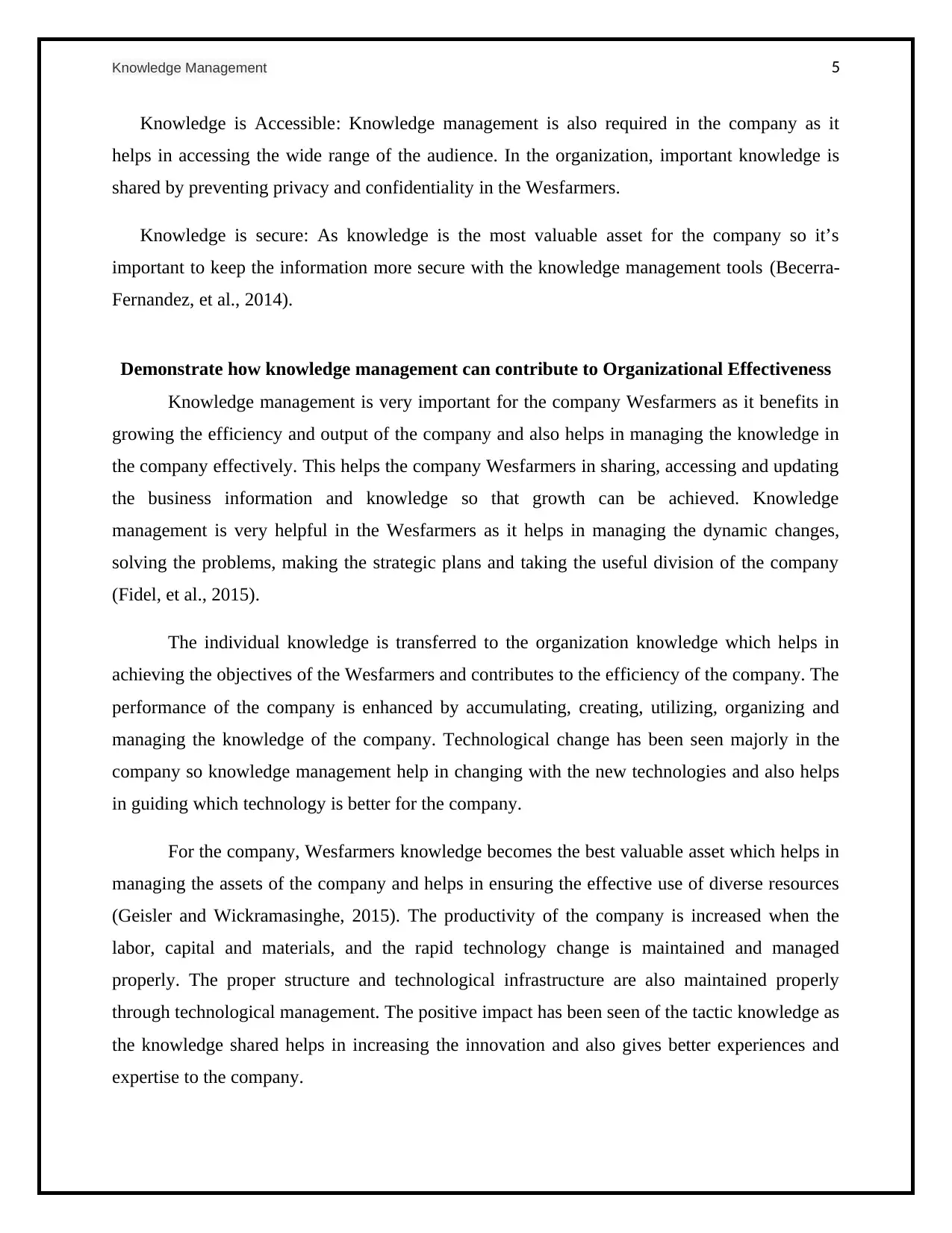
Knowledge Management 5
Knowledge is Accessible: Knowledge management is also required in the company as it
helps in accessing the wide range of the audience. In the organization, important knowledge is
shared by preventing privacy and confidentiality in the Wesfarmers.
Knowledge is secure: As knowledge is the most valuable asset for the company so it’s
important to keep the information more secure with the knowledge management tools (Becerra-
Fernandez, et al., 2014).
Demonstrate how knowledge management can contribute to Organizational Effectiveness
Knowledge management is very important for the company Wesfarmers as it benefits in
growing the efficiency and output of the company and also helps in managing the knowledge in
the company effectively. This helps the company Wesfarmers in sharing, accessing and updating
the business information and knowledge so that growth can be achieved. Knowledge
management is very helpful in the Wesfarmers as it helps in managing the dynamic changes,
solving the problems, making the strategic plans and taking the useful division of the company
(Fidel, et al., 2015).
The individual knowledge is transferred to the organization knowledge which helps in
achieving the objectives of the Wesfarmers and contributes to the efficiency of the company. The
performance of the company is enhanced by accumulating, creating, utilizing, organizing and
managing the knowledge of the company. Technological change has been seen majorly in the
company so knowledge management help in changing with the new technologies and also helps
in guiding which technology is better for the company.
For the company, Wesfarmers knowledge becomes the best valuable asset which helps in
managing the assets of the company and helps in ensuring the effective use of diverse resources
(Geisler and Wickramasinghe, 2015). The productivity of the company is increased when the
labor, capital and materials, and the rapid technology change is maintained and managed
properly. The proper structure and technological infrastructure are also maintained properly
through technological management. The positive impact has been seen of the tactic knowledge as
the knowledge shared helps in increasing the innovation and also gives better experiences and
expertise to the company.
Knowledge is Accessible: Knowledge management is also required in the company as it
helps in accessing the wide range of the audience. In the organization, important knowledge is
shared by preventing privacy and confidentiality in the Wesfarmers.
Knowledge is secure: As knowledge is the most valuable asset for the company so it’s
important to keep the information more secure with the knowledge management tools (Becerra-
Fernandez, et al., 2014).
Demonstrate how knowledge management can contribute to Organizational Effectiveness
Knowledge management is very important for the company Wesfarmers as it benefits in
growing the efficiency and output of the company and also helps in managing the knowledge in
the company effectively. This helps the company Wesfarmers in sharing, accessing and updating
the business information and knowledge so that growth can be achieved. Knowledge
management is very helpful in the Wesfarmers as it helps in managing the dynamic changes,
solving the problems, making the strategic plans and taking the useful division of the company
(Fidel, et al., 2015).
The individual knowledge is transferred to the organization knowledge which helps in
achieving the objectives of the Wesfarmers and contributes to the efficiency of the company. The
performance of the company is enhanced by accumulating, creating, utilizing, organizing and
managing the knowledge of the company. Technological change has been seen majorly in the
company so knowledge management help in changing with the new technologies and also helps
in guiding which technology is better for the company.
For the company, Wesfarmers knowledge becomes the best valuable asset which helps in
managing the assets of the company and helps in ensuring the effective use of diverse resources
(Geisler and Wickramasinghe, 2015). The productivity of the company is increased when the
labor, capital and materials, and the rapid technology change is maintained and managed
properly. The proper structure and technological infrastructure are also maintained properly
through technological management. The positive impact has been seen of the tactic knowledge as
the knowledge shared helps in increasing the innovation and also gives better experiences and
expertise to the company.
⊘ This is a preview!⊘
Do you want full access?
Subscribe today to unlock all pages.

Trusted by 1+ million students worldwide
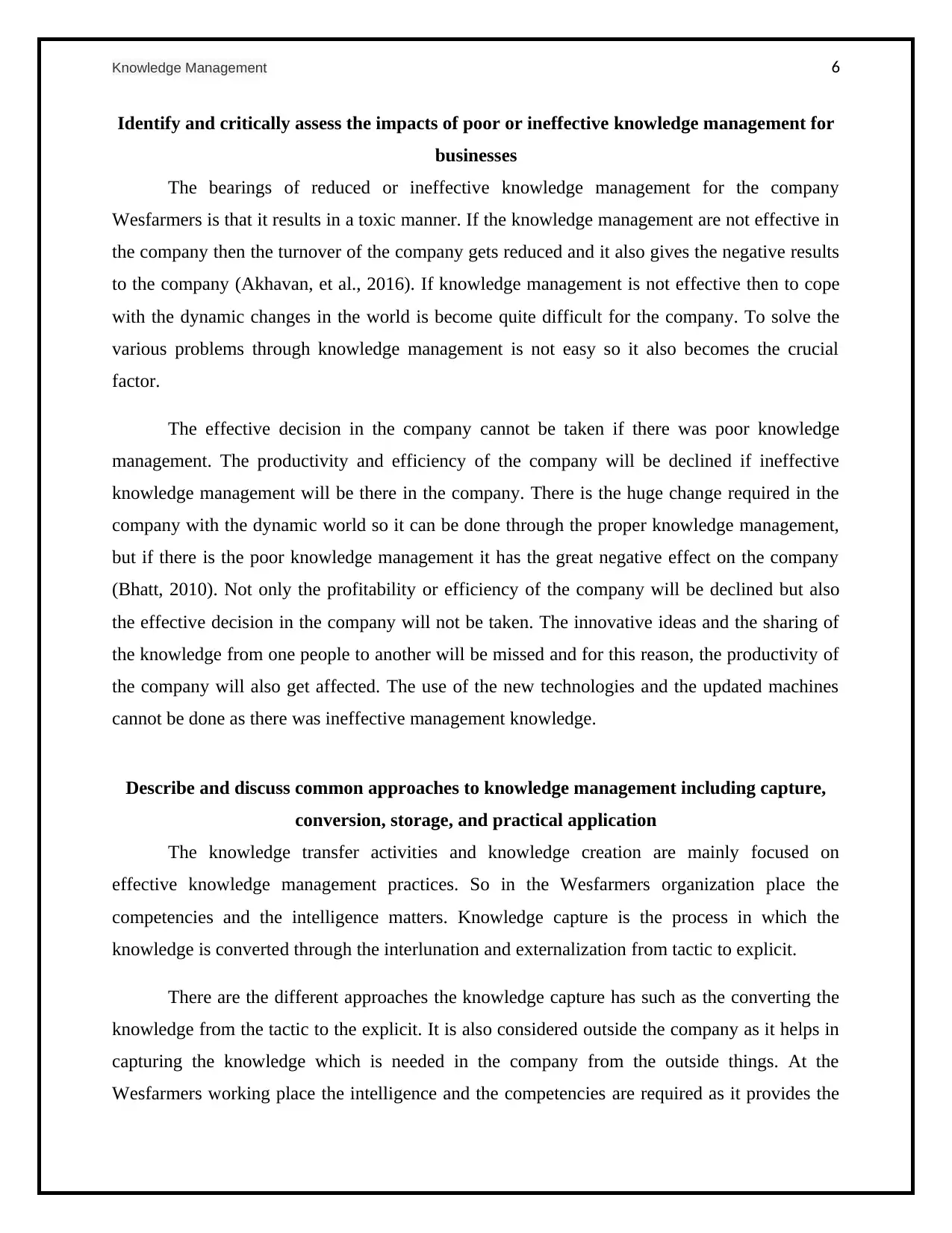
Knowledge Management 6
Identify and critically assess the impacts of poor or ineffective knowledge management for
businesses
The bearings of reduced or ineffective knowledge management for the company
Wesfarmers is that it results in a toxic manner. If the knowledge management are not effective in
the company then the turnover of the company gets reduced and it also gives the negative results
to the company (Akhavan, et al., 2016). If knowledge management is not effective then to cope
with the dynamic changes in the world is become quite difficult for the company. To solve the
various problems through knowledge management is not easy so it also becomes the crucial
factor.
The effective decision in the company cannot be taken if there was poor knowledge
management. The productivity and efficiency of the company will be declined if ineffective
knowledge management will be there in the company. There is the huge change required in the
company with the dynamic world so it can be done through the proper knowledge management,
but if there is the poor knowledge management it has the great negative effect on the company
(Bhatt, 2010). Not only the profitability or efficiency of the company will be declined but also
the effective decision in the company will not be taken. The innovative ideas and the sharing of
the knowledge from one people to another will be missed and for this reason, the productivity of
the company will also get affected. The use of the new technologies and the updated machines
cannot be done as there was ineffective management knowledge.
Describe and discuss common approaches to knowledge management including capture,
conversion, storage, and practical application
The knowledge transfer activities and knowledge creation are mainly focused on
effective knowledge management practices. So in the Wesfarmers organization place the
competencies and the intelligence matters. Knowledge capture is the process in which the
knowledge is converted through the interlunation and externalization from tactic to explicit.
There are the different approaches the knowledge capture has such as the converting the
knowledge from the tactic to the explicit. It is also considered outside the company as it helps in
capturing the knowledge which is needed in the company from the outside things. At the
Wesfarmers working place the intelligence and the competencies are required as it provides the
Identify and critically assess the impacts of poor or ineffective knowledge management for
businesses
The bearings of reduced or ineffective knowledge management for the company
Wesfarmers is that it results in a toxic manner. If the knowledge management are not effective in
the company then the turnover of the company gets reduced and it also gives the negative results
to the company (Akhavan, et al., 2016). If knowledge management is not effective then to cope
with the dynamic changes in the world is become quite difficult for the company. To solve the
various problems through knowledge management is not easy so it also becomes the crucial
factor.
The effective decision in the company cannot be taken if there was poor knowledge
management. The productivity and efficiency of the company will be declined if ineffective
knowledge management will be there in the company. There is the huge change required in the
company with the dynamic world so it can be done through the proper knowledge management,
but if there is the poor knowledge management it has the great negative effect on the company
(Bhatt, 2010). Not only the profitability or efficiency of the company will be declined but also
the effective decision in the company will not be taken. The innovative ideas and the sharing of
the knowledge from one people to another will be missed and for this reason, the productivity of
the company will also get affected. The use of the new technologies and the updated machines
cannot be done as there was ineffective management knowledge.
Describe and discuss common approaches to knowledge management including capture,
conversion, storage, and practical application
The knowledge transfer activities and knowledge creation are mainly focused on
effective knowledge management practices. So in the Wesfarmers organization place the
competencies and the intelligence matters. Knowledge capture is the process in which the
knowledge is converted through the interlunation and externalization from tactic to explicit.
There are the different approaches the knowledge capture has such as the converting the
knowledge from the tactic to the explicit. It is also considered outside the company as it helps in
capturing the knowledge which is needed in the company from the outside things. At the
Wesfarmers working place the intelligence and the competencies are required as it provides the
Paraphrase This Document
Need a fresh take? Get an instant paraphrase of this document with our AI Paraphraser
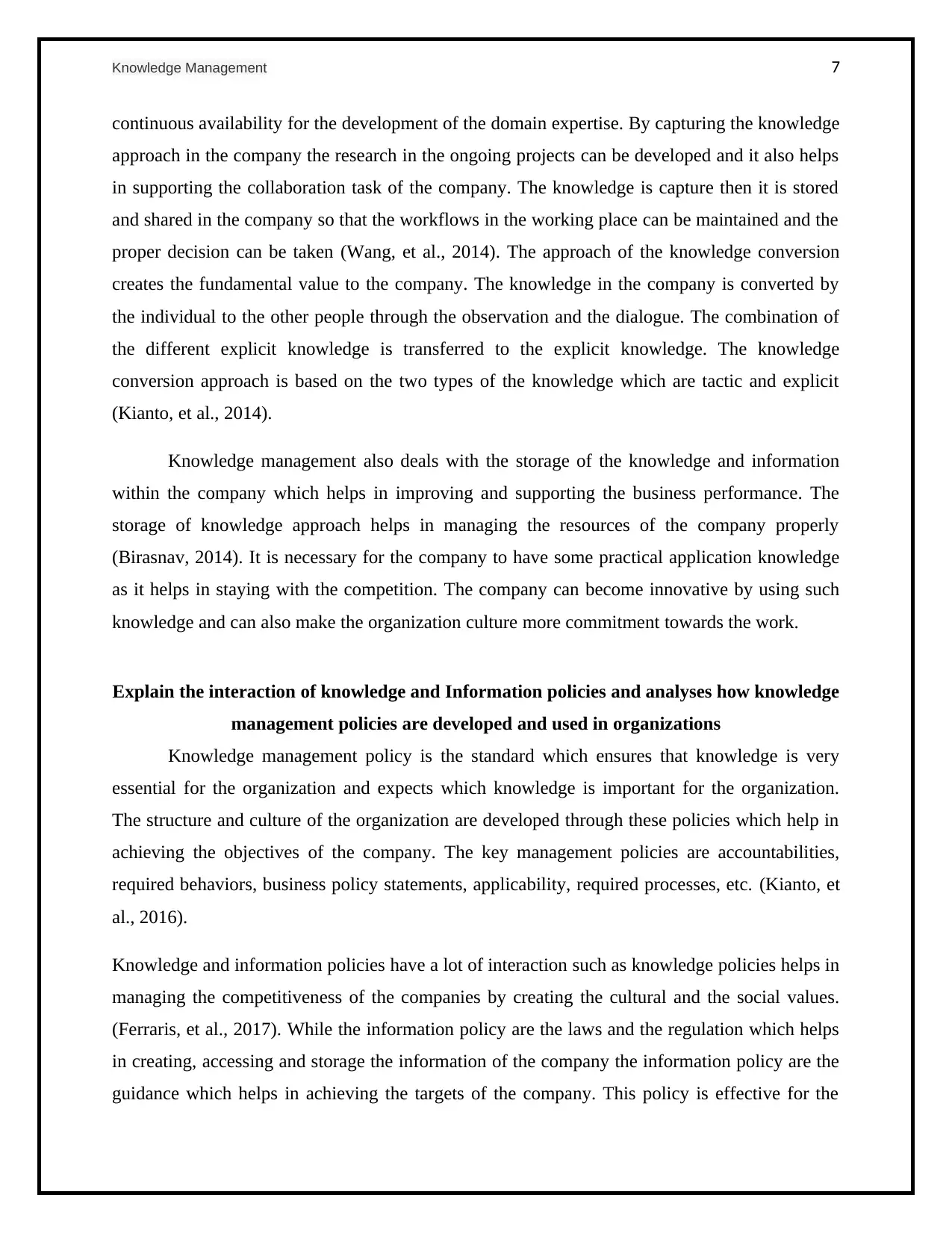
Knowledge Management 7
continuous availability for the development of the domain expertise. By capturing the knowledge
approach in the company the research in the ongoing projects can be developed and it also helps
in supporting the collaboration task of the company. The knowledge is capture then it is stored
and shared in the company so that the workflows in the working place can be maintained and the
proper decision can be taken (Wang, et al., 2014). The approach of the knowledge conversion
creates the fundamental value to the company. The knowledge in the company is converted by
the individual to the other people through the observation and the dialogue. The combination of
the different explicit knowledge is transferred to the explicit knowledge. The knowledge
conversion approach is based on the two types of the knowledge which are tactic and explicit
(Kianto, et al., 2014).
Knowledge management also deals with the storage of the knowledge and information
within the company which helps in improving and supporting the business performance. The
storage of knowledge approach helps in managing the resources of the company properly
(Birasnav, 2014). It is necessary for the company to have some practical application knowledge
as it helps in staying with the competition. The company can become innovative by using such
knowledge and can also make the organization culture more commitment towards the work.
Explain the interaction of knowledge and Information policies and analyses how knowledge
management policies are developed and used in organizations
Knowledge management policy is the standard which ensures that knowledge is very
essential for the organization and expects which knowledge is important for the organization.
The structure and culture of the organization are developed through these policies which help in
achieving the objectives of the company. The key management policies are accountabilities,
required behaviors, business policy statements, applicability, required processes, etc. (Kianto, et
al., 2016).
Knowledge and information policies have a lot of interaction such as knowledge policies helps in
managing the competitiveness of the companies by creating the cultural and the social values.
(Ferraris, et al., 2017). While the information policy are the laws and the regulation which helps
in creating, accessing and storage the information of the company the information policy are the
guidance which helps in achieving the targets of the company. This policy is effective for the
continuous availability for the development of the domain expertise. By capturing the knowledge
approach in the company the research in the ongoing projects can be developed and it also helps
in supporting the collaboration task of the company. The knowledge is capture then it is stored
and shared in the company so that the workflows in the working place can be maintained and the
proper decision can be taken (Wang, et al., 2014). The approach of the knowledge conversion
creates the fundamental value to the company. The knowledge in the company is converted by
the individual to the other people through the observation and the dialogue. The combination of
the different explicit knowledge is transferred to the explicit knowledge. The knowledge
conversion approach is based on the two types of the knowledge which are tactic and explicit
(Kianto, et al., 2014).
Knowledge management also deals with the storage of the knowledge and information
within the company which helps in improving and supporting the business performance. The
storage of knowledge approach helps in managing the resources of the company properly
(Birasnav, 2014). It is necessary for the company to have some practical application knowledge
as it helps in staying with the competition. The company can become innovative by using such
knowledge and can also make the organization culture more commitment towards the work.
Explain the interaction of knowledge and Information policies and analyses how knowledge
management policies are developed and used in organizations
Knowledge management policy is the standard which ensures that knowledge is very
essential for the organization and expects which knowledge is important for the organization.
The structure and culture of the organization are developed through these policies which help in
achieving the objectives of the company. The key management policies are accountabilities,
required behaviors, business policy statements, applicability, required processes, etc. (Kianto, et
al., 2016).
Knowledge and information policies have a lot of interaction such as knowledge policies helps in
managing the competitiveness of the companies by creating the cultural and the social values.
(Ferraris, et al., 2017). While the information policy are the laws and the regulation which helps
in creating, accessing and storage the information of the company the information policy are the
guidance which helps in achieving the targets of the company. This policy is effective for the
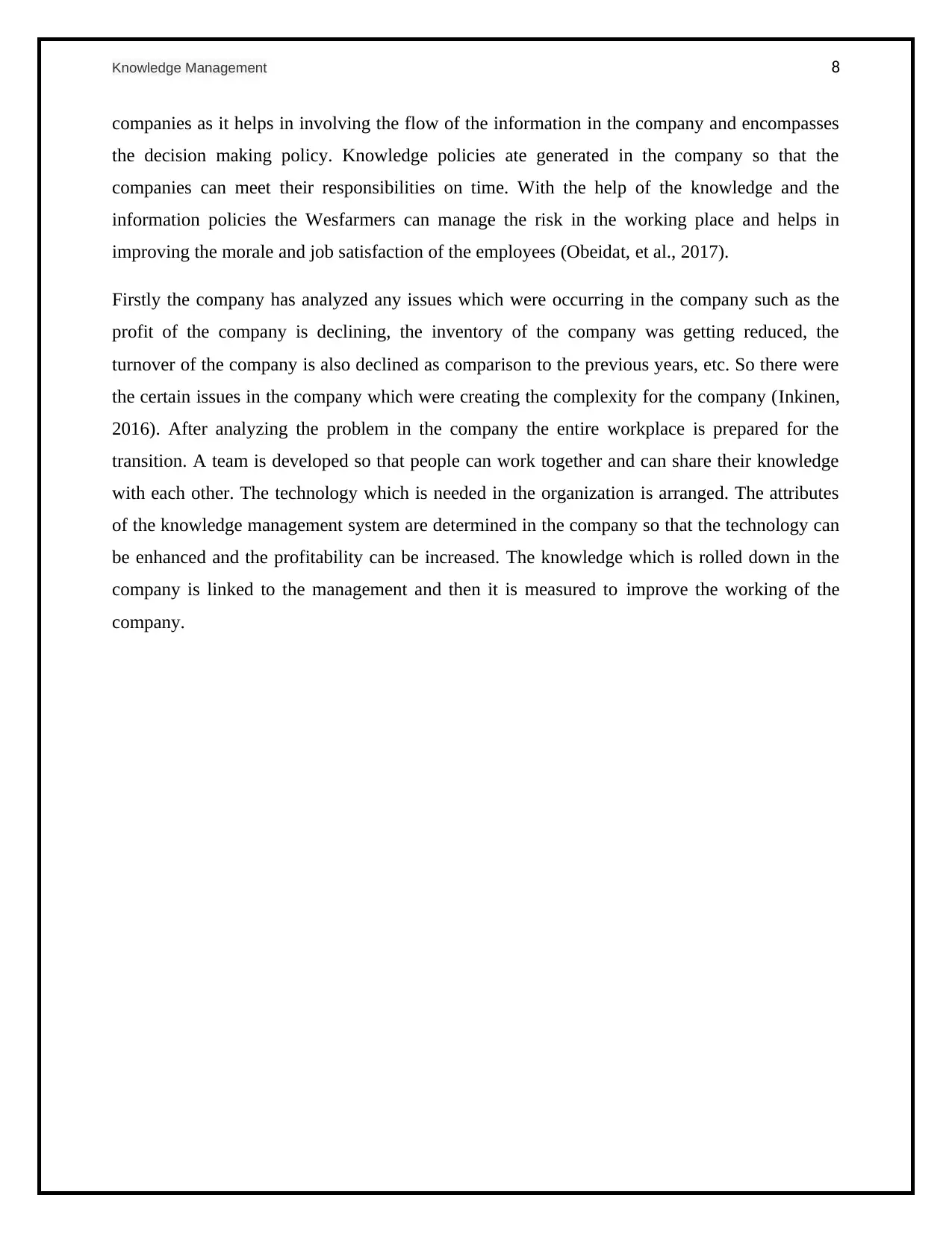
Knowledge Management 8
companies as it helps in involving the flow of the information in the company and encompasses
the decision making policy. Knowledge policies ate generated in the company so that the
companies can meet their responsibilities on time. With the help of the knowledge and the
information policies the Wesfarmers can manage the risk in the working place and helps in
improving the morale and job satisfaction of the employees (Obeidat, et al., 2017).
Firstly the company has analyzed any issues which were occurring in the company such as the
profit of the company is declining, the inventory of the company was getting reduced, the
turnover of the company is also declined as comparison to the previous years, etc. So there were
the certain issues in the company which were creating the complexity for the company (Inkinen,
2016). After analyzing the problem in the company the entire workplace is prepared for the
transition. A team is developed so that people can work together and can share their knowledge
with each other. The technology which is needed in the organization is arranged. The attributes
of the knowledge management system are determined in the company so that the technology can
be enhanced and the profitability can be increased. The knowledge which is rolled down in the
company is linked to the management and then it is measured to improve the working of the
company.
companies as it helps in involving the flow of the information in the company and encompasses
the decision making policy. Knowledge policies ate generated in the company so that the
companies can meet their responsibilities on time. With the help of the knowledge and the
information policies the Wesfarmers can manage the risk in the working place and helps in
improving the morale and job satisfaction of the employees (Obeidat, et al., 2017).
Firstly the company has analyzed any issues which were occurring in the company such as the
profit of the company is declining, the inventory of the company was getting reduced, the
turnover of the company is also declined as comparison to the previous years, etc. So there were
the certain issues in the company which were creating the complexity for the company (Inkinen,
2016). After analyzing the problem in the company the entire workplace is prepared for the
transition. A team is developed so that people can work together and can share their knowledge
with each other. The technology which is needed in the organization is arranged. The attributes
of the knowledge management system are determined in the company so that the technology can
be enhanced and the profitability can be increased. The knowledge which is rolled down in the
company is linked to the management and then it is measured to improve the working of the
company.
⊘ This is a preview!⊘
Do you want full access?
Subscribe today to unlock all pages.

Trusted by 1+ million students worldwide
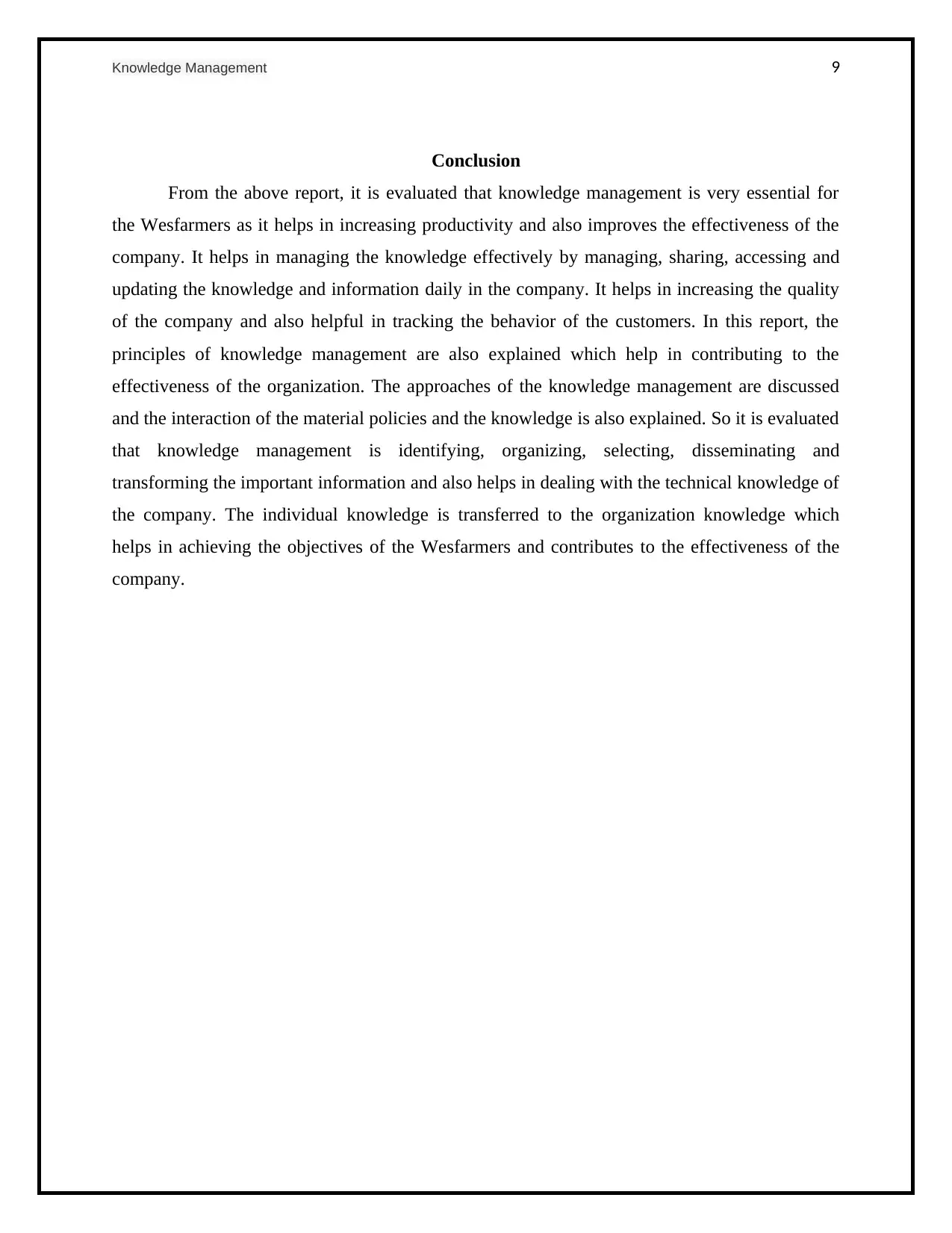
Knowledge Management 9
Conclusion
From the above report, it is evaluated that knowledge management is very essential for
the Wesfarmers as it helps in increasing productivity and also improves the effectiveness of the
company. It helps in managing the knowledge effectively by managing, sharing, accessing and
updating the knowledge and information daily in the company. It helps in increasing the quality
of the company and also helpful in tracking the behavior of the customers. In this report, the
principles of knowledge management are also explained which help in contributing to the
effectiveness of the organization. The approaches of the knowledge management are discussed
and the interaction of the material policies and the knowledge is also explained. So it is evaluated
that knowledge management is identifying, organizing, selecting, disseminating and
transforming the important information and also helps in dealing with the technical knowledge of
the company. The individual knowledge is transferred to the organization knowledge which
helps in achieving the objectives of the Wesfarmers and contributes to the effectiveness of the
company.
Conclusion
From the above report, it is evaluated that knowledge management is very essential for
the Wesfarmers as it helps in increasing productivity and also improves the effectiveness of the
company. It helps in managing the knowledge effectively by managing, sharing, accessing and
updating the knowledge and information daily in the company. It helps in increasing the quality
of the company and also helpful in tracking the behavior of the customers. In this report, the
principles of knowledge management are also explained which help in contributing to the
effectiveness of the organization. The approaches of the knowledge management are discussed
and the interaction of the material policies and the knowledge is also explained. So it is evaluated
that knowledge management is identifying, organizing, selecting, disseminating and
transforming the important information and also helps in dealing with the technical knowledge of
the company. The individual knowledge is transferred to the organization knowledge which
helps in achieving the objectives of the Wesfarmers and contributes to the effectiveness of the
company.
Paraphrase This Document
Need a fresh take? Get an instant paraphrase of this document with our AI Paraphraser
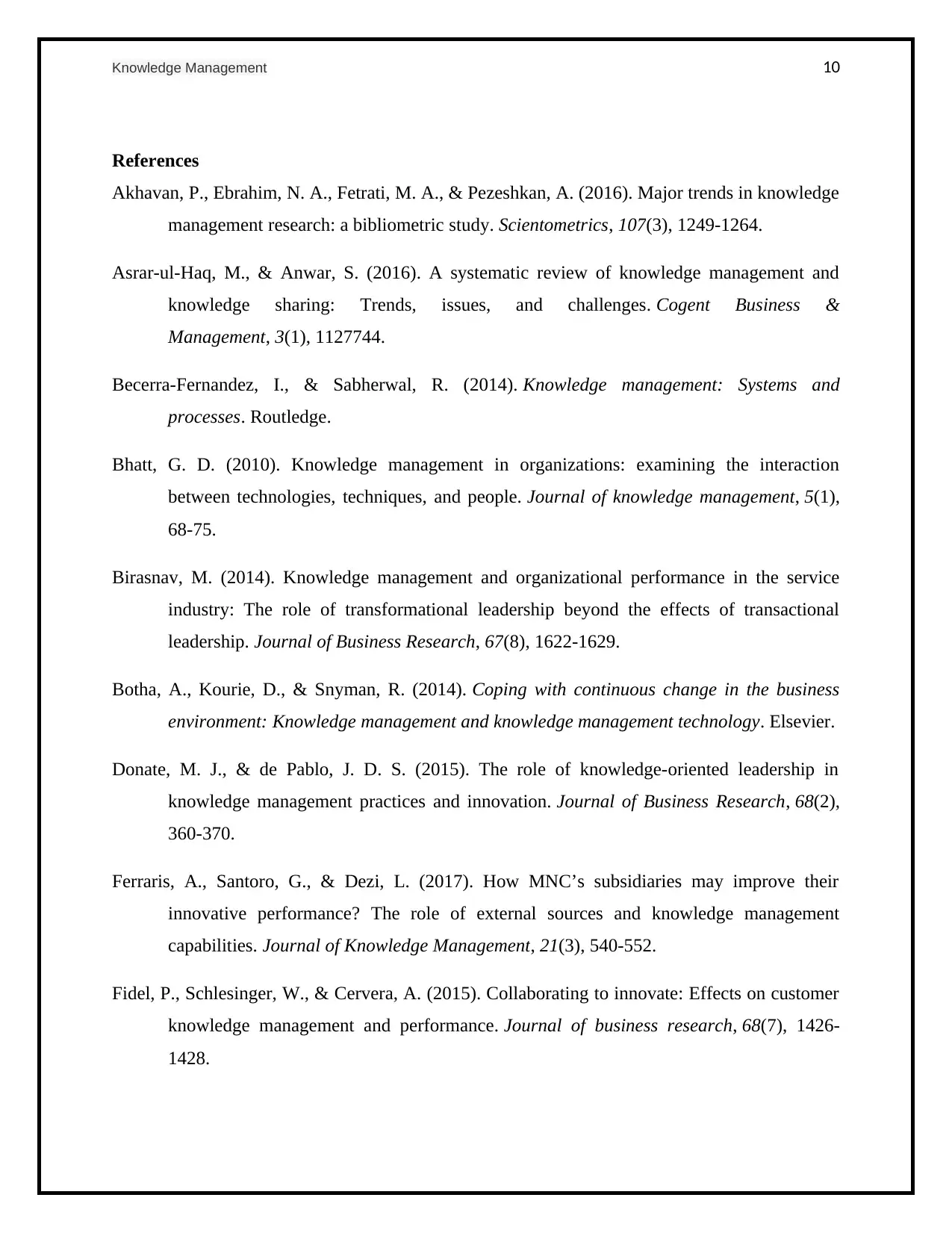
Knowledge Management 10
References
Akhavan, P., Ebrahim, N. A., Fetrati, M. A., & Pezeshkan, A. (2016). Major trends in knowledge
management research: a bibliometric study. Scientometrics, 107(3), 1249-1264.
Asrar-ul-Haq, M., & Anwar, S. (2016). A systematic review of knowledge management and
knowledge sharing: Trends, issues, and challenges. Cogent Business &
Management, 3(1), 1127744.
Becerra-Fernandez, I., & Sabherwal, R. (2014). Knowledge management: Systems and
processes. Routledge.
Bhatt, G. D. (2010). Knowledge management in organizations: examining the interaction
between technologies, techniques, and people. Journal of knowledge management, 5(1),
68-75.
Birasnav, M. (2014). Knowledge management and organizational performance in the service
industry: The role of transformational leadership beyond the effects of transactional
leadership. Journal of Business Research, 67(8), 1622-1629.
Botha, A., Kourie, D., & Snyman, R. (2014). Coping with continuous change in the business
environment: Knowledge management and knowledge management technology. Elsevier.
Donate, M. J., & de Pablo, J. D. S. (2015). The role of knowledge-oriented leadership in
knowledge management practices and innovation. Journal of Business Research, 68(2),
360-370.
Ferraris, A., Santoro, G., & Dezi, L. (2017). How MNC’s subsidiaries may improve their
innovative performance? The role of external sources and knowledge management
capabilities. Journal of Knowledge Management, 21(3), 540-552.
Fidel, P., Schlesinger, W., & Cervera, A. (2015). Collaborating to innovate: Effects on customer
knowledge management and performance. Journal of business research, 68(7), 1426-
1428.
References
Akhavan, P., Ebrahim, N. A., Fetrati, M. A., & Pezeshkan, A. (2016). Major trends in knowledge
management research: a bibliometric study. Scientometrics, 107(3), 1249-1264.
Asrar-ul-Haq, M., & Anwar, S. (2016). A systematic review of knowledge management and
knowledge sharing: Trends, issues, and challenges. Cogent Business &
Management, 3(1), 1127744.
Becerra-Fernandez, I., & Sabherwal, R. (2014). Knowledge management: Systems and
processes. Routledge.
Bhatt, G. D. (2010). Knowledge management in organizations: examining the interaction
between technologies, techniques, and people. Journal of knowledge management, 5(1),
68-75.
Birasnav, M. (2014). Knowledge management and organizational performance in the service
industry: The role of transformational leadership beyond the effects of transactional
leadership. Journal of Business Research, 67(8), 1622-1629.
Botha, A., Kourie, D., & Snyman, R. (2014). Coping with continuous change in the business
environment: Knowledge management and knowledge management technology. Elsevier.
Donate, M. J., & de Pablo, J. D. S. (2015). The role of knowledge-oriented leadership in
knowledge management practices and innovation. Journal of Business Research, 68(2),
360-370.
Ferraris, A., Santoro, G., & Dezi, L. (2017). How MNC’s subsidiaries may improve their
innovative performance? The role of external sources and knowledge management
capabilities. Journal of Knowledge Management, 21(3), 540-552.
Fidel, P., Schlesinger, W., & Cervera, A. (2015). Collaborating to innovate: Effects on customer
knowledge management and performance. Journal of business research, 68(7), 1426-
1428.
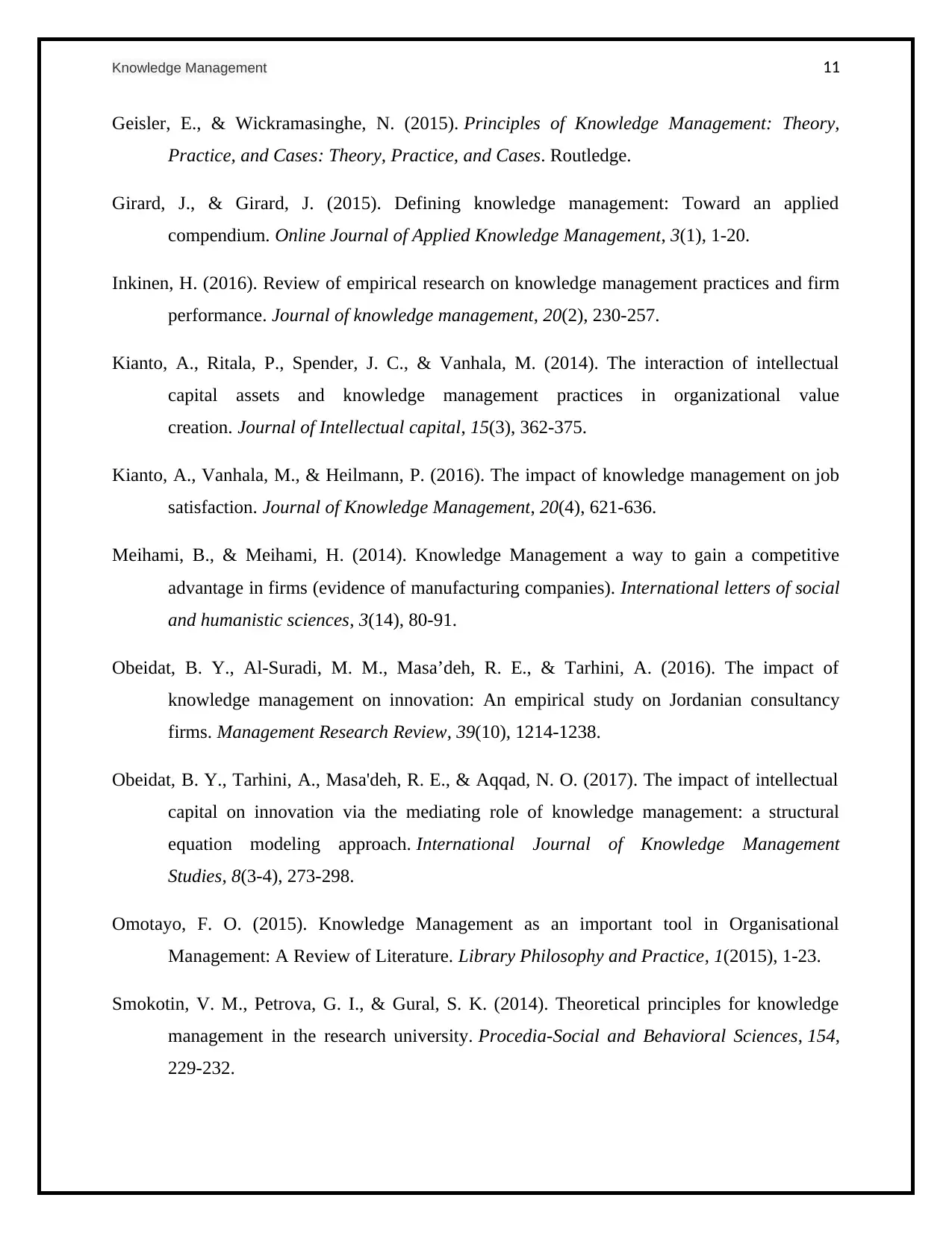
Knowledge Management 11
Geisler, E., & Wickramasinghe, N. (2015). Principles of Knowledge Management: Theory,
Practice, and Cases: Theory, Practice, and Cases. Routledge.
Girard, J., & Girard, J. (2015). Defining knowledge management: Toward an applied
compendium. Online Journal of Applied Knowledge Management, 3(1), 1-20.
Inkinen, H. (2016). Review of empirical research on knowledge management practices and firm
performance. Journal of knowledge management, 20(2), 230-257.
Kianto, A., Ritala, P., Spender, J. C., & Vanhala, M. (2014). The interaction of intellectual
capital assets and knowledge management practices in organizational value
creation. Journal of Intellectual capital, 15(3), 362-375.
Kianto, A., Vanhala, M., & Heilmann, P. (2016). The impact of knowledge management on job
satisfaction. Journal of Knowledge Management, 20(4), 621-636.
Meihami, B., & Meihami, H. (2014). Knowledge Management a way to gain a competitive
advantage in firms (evidence of manufacturing companies). International letters of social
and humanistic sciences, 3(14), 80-91.
Obeidat, B. Y., Al-Suradi, M. M., Masa’deh, R. E., & Tarhini, A. (2016). The impact of
knowledge management on innovation: An empirical study on Jordanian consultancy
firms. Management Research Review, 39(10), 1214-1238.
Obeidat, B. Y., Tarhini, A., Masa'deh, R. E., & Aqqad, N. O. (2017). The impact of intellectual
capital on innovation via the mediating role of knowledge management: a structural
equation modeling approach. International Journal of Knowledge Management
Studies, 8(3-4), 273-298.
Omotayo, F. O. (2015). Knowledge Management as an important tool in Organisational
Management: A Review of Literature. Library Philosophy and Practice, 1(2015), 1-23.
Smokotin, V. M., Petrova, G. I., & Gural, S. K. (2014). Theoretical principles for knowledge
management in the research university. Procedia-Social and Behavioral Sciences, 154,
229-232.
Geisler, E., & Wickramasinghe, N. (2015). Principles of Knowledge Management: Theory,
Practice, and Cases: Theory, Practice, and Cases. Routledge.
Girard, J., & Girard, J. (2015). Defining knowledge management: Toward an applied
compendium. Online Journal of Applied Knowledge Management, 3(1), 1-20.
Inkinen, H. (2016). Review of empirical research on knowledge management practices and firm
performance. Journal of knowledge management, 20(2), 230-257.
Kianto, A., Ritala, P., Spender, J. C., & Vanhala, M. (2014). The interaction of intellectual
capital assets and knowledge management practices in organizational value
creation. Journal of Intellectual capital, 15(3), 362-375.
Kianto, A., Vanhala, M., & Heilmann, P. (2016). The impact of knowledge management on job
satisfaction. Journal of Knowledge Management, 20(4), 621-636.
Meihami, B., & Meihami, H. (2014). Knowledge Management a way to gain a competitive
advantage in firms (evidence of manufacturing companies). International letters of social
and humanistic sciences, 3(14), 80-91.
Obeidat, B. Y., Al-Suradi, M. M., Masa’deh, R. E., & Tarhini, A. (2016). The impact of
knowledge management on innovation: An empirical study on Jordanian consultancy
firms. Management Research Review, 39(10), 1214-1238.
Obeidat, B. Y., Tarhini, A., Masa'deh, R. E., & Aqqad, N. O. (2017). The impact of intellectual
capital on innovation via the mediating role of knowledge management: a structural
equation modeling approach. International Journal of Knowledge Management
Studies, 8(3-4), 273-298.
Omotayo, F. O. (2015). Knowledge Management as an important tool in Organisational
Management: A Review of Literature. Library Philosophy and Practice, 1(2015), 1-23.
Smokotin, V. M., Petrova, G. I., & Gural, S. K. (2014). Theoretical principles for knowledge
management in the research university. Procedia-Social and Behavioral Sciences, 154,
229-232.
⊘ This is a preview!⊘
Do you want full access?
Subscribe today to unlock all pages.

Trusted by 1+ million students worldwide
1 out of 13
Related Documents
Your All-in-One AI-Powered Toolkit for Academic Success.
+13062052269
info@desklib.com
Available 24*7 on WhatsApp / Email
![[object Object]](/_next/static/media/star-bottom.7253800d.svg)
Unlock your academic potential
Copyright © 2020–2025 A2Z Services. All Rights Reserved. Developed and managed by ZUCOL.





